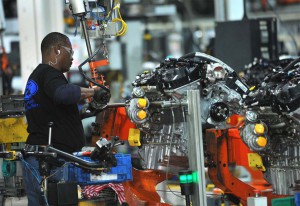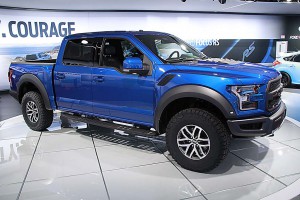Even with cheap gas, motorists have been migrating away from traditional engine choices, and that’s convinced Ford to pump $145 million into the Cleveland Engine Plant producing one of its key alternatives, the 3.5-liter EcoBoost engine used in a variety of models such as the big F-150 pickup.
Ford plans to make the turbocharged engine – which serves as an alternative to traditional V-8s – available on a wider line-up of vehicles in the coming years. It’s taking a similar approach with other members of the EcoBoost family which include engines as small as a 1.0-liter 3-cylinder package.
“Ford customers have embraced EcoBoost’s unbeatable combination of power and efficiency, with more than 60% of F-150 customers choosing trucks powered by EcoBoost,” said Joe Hinrichs, Ford President of The Americas Joe Hinrichs, said in a statement.
Add a naturally aspirated – or non-turbo – V-6 option, and about two-thirds of F-150 buyers no longer use V-8s in the full-size truck. That’s an unheard of transformation in a market segment where V-8s were the overwhelming option of choice until recently.
But the same shift is occurring across the Ford line-up. The maker has seen a rapid growth of its turbocharged EcoBoost models in a wide range of products, from the little Fiesta hatchback to the big Expedition SUV. Even the Mustang now has an EcoBoost option.
(Updated Ford Fusion gets “pothole protection.” Click Here for the story.)
And Ford isn’t alone. Virtually all diesels now use turbochargers, as do a growing number of gasoline engines. A study by Honeywell, a major supplier of the turbos, estimated the technology could be found on as much as 80% of the vehicles sold worldwide by decade’s end, up from barely 25% in 2014.
Honda is adding its first mainstream turbo version of the Civic this year, with an assortment of new engines – dubbed Earth Dreams – being added to its line-up. General Motors is just launching a new flagship for its Cadillac line, and the top version of the new Caddy CT6 is powered by a twin-turbo 3.0-liter V6, rather than the big V-8 traditionally required of a large luxury car. Volvo is abandoning six and eight-cylinder models entirely.
(Infiniti powers up with three new engines for new Q50 model. Click Here for more.)
The 3.5-liter engine is the largest in an expanding Ford EcoBoost family that was first introduced in 2009. It currently is used in a mix of models including not only the F-150 pickup but the Explorer, Expedition and Flex utility vehicles and the Taurus sedan.
The $145 million project announced today will allow Ford to transition to a more advanced, second-generation version of the engine, adding a special version specifically for the F-150 Raptor, a serious off-road version of the full-size truck. It’s the first time a Raptor will be offered with an EcoBoost.
It will replace the old 6.2-liter V-8 used in the Raptor. According to Ford, it will match the power of the old engine while significantly boosting fuel efficiency. Notably the second-gen EcoBoost will be paired with an all-new 10-speed automatic transmission
The investment will also upgrade the plant and expand its production capabilities. The Cleveland factory currently employs about 1,500. It has so far produced over 1 million EcoBoost engines.
(From Insight to NSX, green cars to dominate at Honda. Click Here for the story.)


